July 2015
July 31, 2015
Color-Changing Fur Bra
In case of power outage, she could take the place of traffic lights.
More in extended >>
Posted By: Alex - Fri Jul 31, 2015 -
Comments (8)
Category: Fashion, Underwear
The Apple
Explanation here--insofar as is possible.
Posted By: Paul - Fri Jul 31, 2015 -
Comments (6)
Category: Drugs, Ineptness, Crudity, Talentlessness, Kitsch, and Bad Art, Music, Science Fiction, 1980s
July 30, 2015
Sleeping Time
I like this guy's way of thinking. Too bad the judge didn't go for it.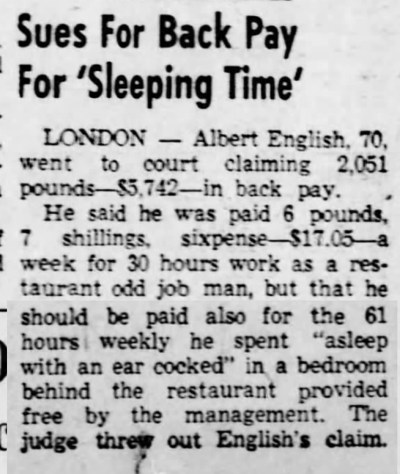
Altoona Tribune - Jan 21, 1957
LONDON — Albert English, 70, went to court claiming 2,051 pounds—$5,742—in back pay.
He said he was paid 6 pounds, 7 shillings, sixpense—$17.05—a week for 30 hours work as a restaurant odd job man, but that he should be paid also for the 61 hours weekly he spent "asleep with an ear cocked" in a bedroom behind the restaurant provided free by the management. The judge threw out English's claim.
Posted By: Alex - Thu Jul 30, 2015 -
Comments (2)
Category: Jobs and Occupations, 1950s
Great Moments in State Tourism Promotion

Original ad here.
Posted By: Paul - Thu Jul 30, 2015 -
Comments (7)
Category: Racism, Slavery, Bondage and Indenture, Flags, Tourists and Tourism, 1950s
July 29, 2015
Geek Orgasm Day

Windows 10 is now officially released. I've been up since midnight updating PC's.
My hand is getting tired :roll:
It's nice being off work after being in the hospital to enjoy this day.
Posted By: BrokeDad - Wed Jul 29, 2015 -
Comments (22)
Category: Computers
Rolling Pin Throwing Contest, 1928
Providing the proper motivation: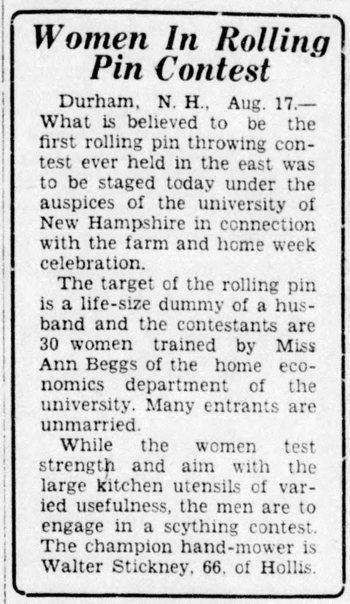
The Salem News (Salem, Ohio) - Aug 17, 1928
Winners of a 1932 rolling pin contest (via NCSU Libraries):
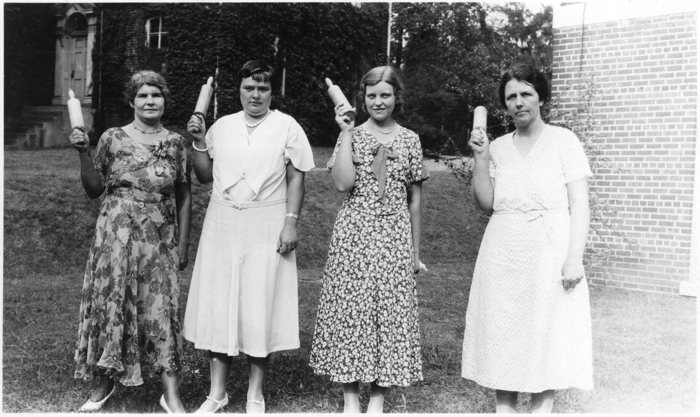
Posted By: Alex - Wed Jul 29, 2015 -
Comments (6)
Category: Sports, Husbands, 1920s
Kissing Chickens
"They ain't got no lips!"
Posted By: Paul - Wed Jul 29, 2015 -
Comments (3)
Category: Agriculture, Animals, PSA’s, Diseases
July 28, 2015
Man vs. Horse, 1947
The experts predicted that the man vs. horse tug-of-war organized in Waterloo, Oregon back in 1947 would be no contest at all. The man, 225-pound Chester Fitzwater, was lying on the ground, his feet braced against a wood block. To win, he simply had to remain in place for three minutes. The horse, Big Baldy, was said not to have a chance.Dr. Raymond T. Ellickson, physics professor at Reed College in Portland, estimated 1900-pound Baldy would have to exert about 16,000 pounds worth of effort to up-end Fitzwater.
Ellickson figured it would take a 3000-pound pull just to get the long rope taut, and then Baldy would have only an angle of 1 degree from the horizontal to pull against.
Other scientists advised about the same, and an even more discouraging report—for old Baldy—came from rope dealers. They said the one-inch rope would break at approximately 9000 pounds of pull—far short of the 16,000 Dr. Ellickson believes necessary.
It took about a second for Big Baldy to prove the experts wrong. As soon as the rope tightened, "Fitzwater lurched into the air, knocked over a photographer and some spectators, and crashed into the mud."
Several other brawny men subsequently challenged the horse to the same contest, believing they would last longer. They didn't.
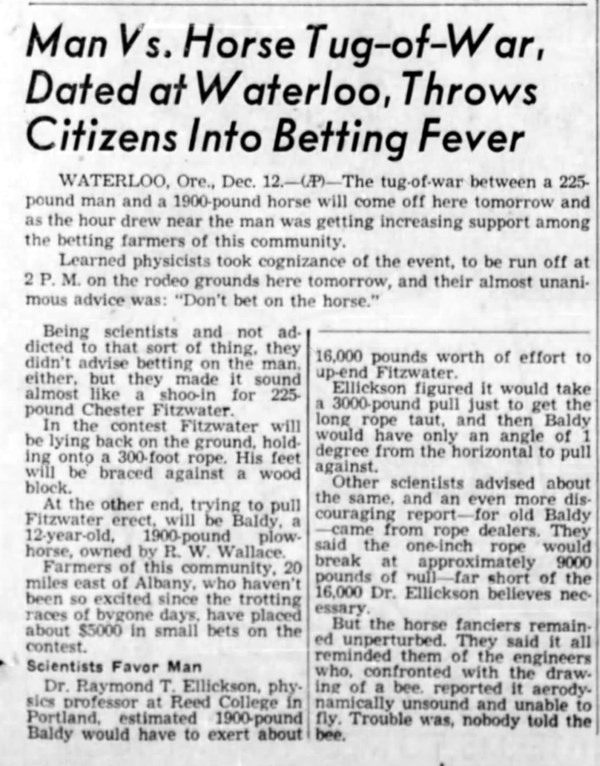
The News-Review (Roseburg, Oregon) - Dec 12, 1947
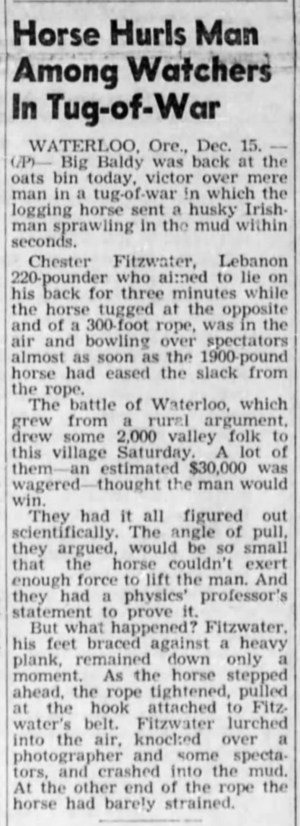
The News-Review (Roseburg, Oregon) - Dec 15, 1947
Posted By: Alex - Tue Jul 28, 2015 -
Comments (6)
Category: Sports, 1940s
Cattle Delivery Via Motorcycle

I really wish this practice had caught on, for I would be delighted to be driving down a highway and see such a sight.
Original article here.
Posted By: Paul - Tue Jul 28, 2015 -
Comments (2)
Category: Animals, Farming, Inventions, 1920s, Motorcycles
July 27, 2015
Hank Robar’s Toilet Art

Since 2004, Robar has battled with the local government over other properties, and as a result Potsdam has been home to a number of his toilet gardens. He's currently in the process of creating a new one.
Robar's toilet art has sparked some lively debate in the community about what exactly qualifies as art.
Update: It says here that Robar's toilets are legal not because they're art, per se, but because they have flowers in them, so he can claim that they're planter boxes, which are allowed under zoning laws. Also, he's not the only guy who's thought of displaying toilets as a protest against local government.
Posted By: Alex - Mon Jul 27, 2015 -
Comments (4)
Category: Art
| Get WU Posts by Email | |
|---|---|

| Who We Are |
|---|
| Alex Boese Alex is the creator and curator of the Museum of Hoaxes. He's also the author of various weird, non-fiction books such as Elephants on Acid. Paul Di Filippo Paul has been paid to put weird ideas into fictional form for over thirty years, in his career as a noted science fiction writer. He has recently begun blogging on many curious topics with three fellow writers at The Inferior 4+1. Chuck Shepherd Chuck is the purveyor of News of the Weird, the syndicated column which for decades has set the gold-standard for reporting on oddities and the bizarre. Our banner was drawn by the legendary underground cartoonist Rick Altergott. Contact Us |

